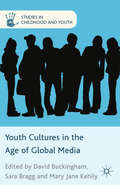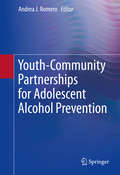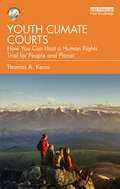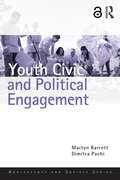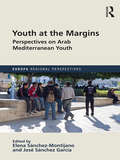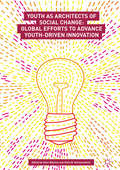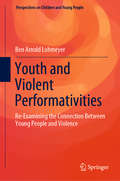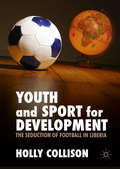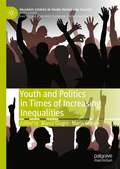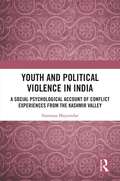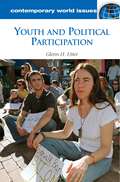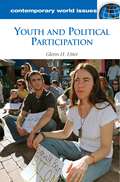- Table View
- List View
Youth Cultures in the Age of Global Media (Studies in Childhood and Youth)
by Mary Jane Kehily Sara BraggThis book explores the impact of globalisation and new technologies on youth cultures around the world, from the Birmingham School to the youthscapes of South Korea. In a timely reappraisal of youth cultures in contemporary times, this collection profiles the best of new research in youth studies written by leading scholars in the field.
Youth-Community Partnerships for Adolescent Alcohol Prevention
by Andrea J. RomeroThis forward-thinking reference spotlights an expansive and inclusive community model for youth alcohol prevention as opposed to traditional individual and school-based group approaches. Focusing on a long-term intervention in a Southwestern border town, it documents the development of critical consciousness in an affected community, and emphasizes young people as crucial drivers of change in their environment. The book’s Community Readiness Model provides vital context for successful coalition building between youth, families, and community entities (e.g., schools, civic leaders, police) in reducing alcohol risk factors and promoting healthier choices. Given the severity and prevalence of youth alcohol use, this case study offers a viable blueprint for large-scale engagement in prevention. Among the featured topics: Integrating research into prevention strategies using participatory action research. Breaking down silos between community-based organizations: coalition development. Adult perspectives on nurturing youth leadership and coalition participation. Youth perspectives on youth power as the source of community development. Coalition as conclusion: tips on creating a functioning coalition. Community transformational resilience for adolescent alcohol prevention. Youth-Community Partnerships for Adolescent Alcohol Prevention is both practical and inspiring reading for researchers and other mental health professionals in psychology, social work, and public health who work with adolescents, communities, and civic engagement.
The Youth Climate Uprising: From the School Strike Movement to an Ecophilosophy of Democracy (X-Texte zu Kultur und Gesellschaft)
by David Fopp Isabelle Axelsson Loukina TilleSpecies are going extinct, forests are burning, and children are worried about the future and their peers worldwide. But that is not the whole story: One Friday in 2018, a few young people joined Greta Thunberg to protest, and the global climate strike movement was born. Scientist David Fopp spent 250 Fridays with the newly formed grassroots movements. Together with activists Isabelle Axelsson and Loukina Tille, he offers an insider perspective on how scientists and activists can fight for a just and sustainable global society. The volume also offers both an introduction to ecophilosophy and a unified science of democracy in times of interdependent crises. How can research in all disciplines - from (drama) education and economics to psychology - help with this struggle? And how can we all fight the climate crisis by transforming and deepening democracy?
Youth Climate Courts: How You Can Host a Human Rights Trial for People and Planet
by Thomas A. KernsThis book focuses on Youth Climate Courts, a bold new tool that young people in their teens and twenties can use to compel their local city or county government to live up to its human rights obligations, formally acknowledge the climate crisis, and take major steps to address it. Tom Kerns shows how youth climate leaders can form their own local Youth Climate Court, with youth judges, youth prosecuting attorneys, and youth jury members, and put their local city or county government on trial for not meeting its human rights obligations. Kerns describes how a Youth Climate Court works, how to start one, what human rights are, what they require of local governments, and what governmental changes a Youth Climate Court can realistically hope to accomplish. The book offers young activists a brand new, user-friendly, cost-free, barrier-free, powerful tool for forcing local governments to come to terms with their obligation to protect the rights of their citizens with respect to the climate crisis. This book offers a unique new tool to young climate activists hungry for genuinely effective ways to directly move governments to aggressively address the climate crisis.
Youth Climate Courts: How You Can Host a Human Rights Trial for People and Planet
by Thomas A. KernsThis book focuses on Youth Climate Courts, a bold new tool that young people in their teens and twenties can use to compel their local city or county government to live up to its human rights obligations, formally acknowledge the climate crisis, and take major steps to address it. Tom Kerns shows how youth climate leaders can form their own local Youth Climate Court, with youth judges, youth prosecuting attorneys, and youth jury members, and put their local city or county government on trial for not meeting its human rights obligations. Kerns describes how a Youth Climate Court works, how to start one, what human rights are, what they require of local governments, and what governmental changes a Youth Climate Court can realistically hope to accomplish. The book offers young activists a brand new, user-friendly, cost-free, barrier-free, powerful tool for forcing local governments to come to terms with their obligation to protect the rights of their citizens with respect to the climate crisis. This book offers a unique new tool to young climate activists hungry for genuinely effective ways to directly move governments to aggressively address the climate crisis.
Youth Civic Engagement in a Globalized World: Citizenship Education in Comparative Perspective (Palgrave Studies in Global Citizenship Education and Democracy)
by Catherine BroomIn this book, the authors explore the apparent decline in youth civic engagement through research studies conducted in seven societies/nations with varied experiences with democracy. This work is framed within a youth civic engagement model. Each subsequent chapter presents the findings for each nation, along with contextual and historical discussions of citizenship education. This book explores the findings in Canada, England, Hong Kong, India, Italy, Japan, and Mexico.
Youth Civic and Political Engagement (ISSN)
by Martyn Barrett Dimitra PachiWhat exactly is civic and political participation? What factors influence young people’s participation? How can we encourage youth to actively participate in their own democracies? Youth Civic and Political Engagement takes a multidisciplinary approach to answering these key questions, incorporating research in the fields of psychology, sociology, political science and education to explore the issues affecting youth civic and political engagement.Drawing on evidence that has been obtained in many different national contexts, and through multinational studies, this book provides a theoretical synthesis of this large and diverse body of research, using an integrative multi-level ecological model of youth engagement to do so. It identifies unresolved issues in the field and offers numerous suggestions for future research.Youth Civic and Political Engagementis an invaluable resource for researchers, teachers, youth workers, civil society activists, policymakers and politicians who wish to acquire an up-to-date understanding of the factors and processes that influence young people’s civic and political engagement, and how to promote youth engagement.Chapters 1, 2, 3, and 4 of this book are freely available as downloadable Open Access PDFs at http://www.taylorfrancis.com under a Creative Commons Attribution-Non Commercial-No Derivatives (CC-BY-NC-ND) 4.0 license.
Youth Civic and Political Engagement (ISSN)
by Martyn Barrett Dimitra PachiWhat exactly is civic and political participation? What factors influence young people’s participation? How can we encourage youth to actively participate in their own democracies? Youth Civic and Political Engagement takes a multidisciplinary approach to answering these key questions, incorporating research in the fields of psychology, sociology, political science and education to explore the issues affecting youth civic and political engagement.Drawing on evidence that has been obtained in many different national contexts, and through multinational studies, this book provides a theoretical synthesis of this large and diverse body of research, using an integrative multi-level ecological model of youth engagement to do so. It identifies unresolved issues in the field and offers numerous suggestions for future research.Youth Civic and Political Engagementis an invaluable resource for researchers, teachers, youth workers, civil society activists, policymakers and politicians who wish to acquire an up-to-date understanding of the factors and processes that influence young people’s civic and political engagement, and how to promote youth engagement.Chapters 1, 2, 3, and 4 of this book are freely available as downloadable Open Access PDFs at http://www.taylorfrancis.com under a Creative Commons Attribution-Non Commercial-No Derivatives (CC-BY-NC-ND) 4.0 license.
Youth at the Margins: Perspectives on Arab Mediterranean Youth (Europa Regional Perspectives)
by Jose Sánchez García Elena Sánchez-MontijanoThe 2011 Arab uprisings led to a great proliferation of studies on the situations in the Arab countries of the Mediterranean, with particular attention given to their young people, whose role was particularly central. Eight years on, in-depth exploration is still needed of the conditions in which millions of (mainly young) people demanded change. In this context, this volume examines the state and diversity of the forms of socioeconomic, political and cultural marginalization facing the region's young men and women, as well as the strategies and routes of contestation by which they escape them. Through the interdisciplinary empiricism of this book, based on the results emerging from the SAHWA Project (funded by the European Commission under the Seventh Framework Programme, grant agreement nº 613174), we aspire to build a complex description and analysis of the current situation of the Arab Mediterranean youth. The aim is to fathom out young people’s patterns, agency and living conditions, focusing on the relational character of the juvenile worlds actively constructed by themselves. The authors explore the main trends that are reflected in the social strategies, cultural constructions and changes within the Arab youth population, and whether the creation of new lifestyles and the emergence of youth cultures are an indicator of sociopolitical transitions. To answer all these questions the researchers have conducted a comprehensive study in five Arab Mediterranean countries: Algeria, Egypt, Lebanon, Morocco and Tunisia. Based on mixed method research the data collection is composed of two primary sources: the SAHWA Youth Survey 2016 (2017), in which 10,000 young people were interviewed; and the SAHWA Ethnographic Fieldwork 2015, involving more than 200 young people.
Youth at the Margins: Perspectives on Arab Mediterranean Youth (Europa Regional Perspectives)
by Sánchez-Montijano Elena Sánchez García JoséThe 2011 Arab uprisings led to a great proliferation of studies on the situations in the Arab countries of the Mediterranean, with particular attention given to their young people, whose role was particularly central. Eight years on, in-depth exploration is still needed of the conditions in which millions of (mainly young) people demanded change. In this context, this volume examines the state and diversity of the forms of socioeconomic, political and cultural marginalization facing the region's young men and women, as well as the strategies and routes of contestation by which they escape them. Through the interdisciplinary empiricism of this book, based on the results emerging from the SAHWA Project (funded by the European Commission under the Seventh Framework Programme, grant agreement nº 613174), we aspire to build a complex description and analysis of the current situation of the Arab Mediterranean youth. The aim is to fathom out young people’s patterns, agency and living conditions, focusing on the relational character of the juvenile worlds actively constructed by themselves. The authors explore the main trends that are reflected in the social strategies, cultural constructions and changes within the Arab youth population, and whether the creation of new lifestyles and the emergence of youth cultures are an indicator of sociopolitical transitions. To answer all these questions the researchers have conducted a comprehensive study in five Arab Mediterranean countries: Algeria, Egypt, Lebanon, Morocco and Tunisia. Based on mixed method research the data collection is composed of two primary sources: the SAHWA Youth Survey 2016 (2017), in which 10,000 young people were interviewed; and the SAHWA Ethnographic Fieldwork 2015, involving more than 200 young people.
Youth as Architects of Social Change: Global Efforts to Advance Youth-Driven Innovation
by Sheri Bastien Halla B. HolmarsdottirThis edited collection outlines the issues central to youth engagement in research and social innovation. Youth-driven innovation for social change is increasingly recognized as holding potential for the development of sustainable strategies to tackle some of the most pressing global challenges of our time. The contributors provide additional knowledge concerning what actually constitutes an enabling environment, as well as the most effective approaches for engaging youth as architects of change. While sensitive to the need for contextual appropriateness, the volume contributes to the development of shared understandings and frameworks for engaging and spurring youth-driven innovation for social change worldwide. Youth-Driven Social Innovation showcases examples of youth engagement in frugal and reverse innovation worldwide, alongside examples which demonstrate the tremendous potential of South-South learning, but also learning and youth innovation in the Global North. It will be of interest to students and scholars across a range of disciplines including education, sociology, anthropology, public health, and politics.
Youth as Architects of Social Change: Global Efforts to Advance Youth-Driven Innovation
by Sheri Bastien Halla B. HolmarsdottirThis edited collection outlines the issues central to youth engagement in research and social innovation. Youth-driven innovation for social change is increasingly recognized as holding potential for the development of sustainable strategies to tackle some of the most pressing global challenges of our time. The contributors provide additional knowledge concerning what actually constitutes an enabling environment, as well as the most effective approaches for engaging youth as architects of change. While sensitive to the need for contextual appropriateness, the volume contributes to the development of shared understandings and frameworks for engaging and spurring youth-driven innovation for social change worldwide. Youth-Driven Social Innovation showcases examples of youth engagement in frugal and reverse innovation worldwide, alongside examples which demonstrate the tremendous potential of South-South learning, but also learning and youth innovation in the Global North. It will be of interest to students and scholars across a range of disciplines including education, sociology, anthropology, public health, and politics.
Youth and Violent Performativities: Re-Examining the Connection Between Young People and Violence (Perspectives on Children and Young People #11)
by Ben Arnold LohmeyerThis book challenges the dominant narrative of young people being a uniquely violent group. Instead, the book critically examines how young people become violent as they enact and resist the available violent performativities in youth. It focuses on the experiences of 28 young people in Australia who are subjected to violence, who use violence and who resist violence. A critical analysis of these young people’s “messy” stories facilitates a reframing of the physical violence routinely attributed to young people as a product of violating systems and structures. The author constructs a converging theoretical landscape to re-examine youth, violence and resistance at the intersection of the sociology of violence and the sociology of youth. Drawing on interviews with young Australians, the book makes a valuable contribution to contemporary international scholarship on youth and violence, while also examining the potential for complicity to violence in youth research and practice. In doing so it offers youth scholars and practitioners a framework for reassessing their theoretical frameworks and methods for studying and working with young people in connection with violence.
Youth and the State in Hungary: Capitalism, Communism and Class (Anthropology, Culture and Society)
by Laszlo KurtiYouth and the State in Hungary takes as its focus the nature of Hungary’s youth movements over the last seventy years. In a detailed ethnographic study, Laszlo Kurti examines the lives of youth workers in the Csepel district of Budapest in the context of the wider political and economic transformations witnessed during the twentieth century.*BR**BR*Kurti follows State-Youth relations from the inter-war capitalism that made peasants into workers, through the post war state socialism – ‘Stalinism’ and after – to the reintroduction of capitalism in 1990. This time frame allows an exploration of the transformations and dilemmas of youth, class, gender and ethnicity as they develop across time. *BR**BR*In the course of this study two main themes emerge: the reproduction of class in youth culture across shifting socio-economic conditions; and the mobilisation of youth movements in resistance to the state. Youth and the State in Hungary challenges the orthodox equation of youth and resistance by arguing that youth mobilisation has, in fact, served the interests of the state. Nevertheless there remains a genuine space for resistance and contestation in the reproduction of youth culture.
Youth and sustainable peacebuilding
by Helen Berents, Catherine Bolten and Siobhán McEvoy-LevySustainable peace involves more than simply including youth in official peacebuilding mechanisms or recognizing their local peacebuilding work; it requires a transformation in thinking about the youth as actors in the world of security and peace. Using case studies from around the globe, the contributors to this volume analyse why states are afraid of their young people, why 'youth participation' in formal peace processes matters but is insufficient, and ways that young people are working outside of official systems to create and nurture peace on their own terms. The volume offers guidance for ways to bridge the disconnect that exists between institutional assumptions and expectations for youth as peacebuilders and the actual sustainable peace leadership of youth. Throughout, it emphasises a critical approach to peacebuilding with, for and by youth.
Youth and sustainable peacebuilding
by Siobhan McEvoy-Levy Helen Berents Catherine BoltenSustainable peace involves more than simply including youth in official peacebuilding mechanisms or recognizing their local peacebuilding work; it requires a transformation in thinking about the youth as actors in the world of security and peace. Using case studies from around the globe, the contributors to this volume analyse why states are afraid of their young people, why 'youth participation' in formal peace processes matters but is insufficient, and ways that young people are working outside of official systems to create and nurture peace on their own terms. The volume offers guidance for ways to bridge the disconnect that exists between institutional assumptions and expectations for youth as peacebuilders and the actual sustainable peace leadership of youth. Throughout, it emphasises a critical approach to peacebuilding with, for and by youth.
Youth and Sport for Development: The Seduction of Football in Liberia
by Holly CollisonProcesses of development concerning reconciliation, rehabilitation and peace-building have become a central theme for global organizations tasked with intervening in broken and divided societies after violent conflicts. What can reunite populations divided by war and violence whilst attempting to build a peaceful civil society? This book considers the impact and value of sport, notably football, towards achieving this goal. Using extensive fieldwork from Liberia, Collison highlights the multiple and diverse stakeholders and actors aligning themselves with ‘Sport for Development and Peace’ interventions. By unpacking and conceptualising the ambiguous terminology, complex social effects and the lived experience of SDP, this book draw upon participant voices and the author’s own lived experience within SDP to gain symbolic understandings of culture, identity and the formal and informal social structures in which participants and interventions operate. Collison identifies that SDP has become fashionable within development agendas but it remains an aspirational image, a notion of seduction, rather than a tested method of reintegration and youth development in post-conflict environments. Youth and Sport for Development questions the assumptions of SDP rhetoric and programs, and traces the effects of football - the favoured vehicle of SDP- on youth in post-conflict Liberia. Examining three core themes: post-conflict development, youth and community, this book centralises the narratives of young football players in Liberia and will appeal to scholars across Anthropology, Sociology, Sports Studies, Politics and Development.
Youth and Revolution in Tunisia (African Arguments)
by Alcinda HonwanaThe uprising in Tunisia has come to be seen as the first true revolution of the twenty-first century, one that kick-started the series of upheavals across the region now known as the Arab Spring. In this remarkable work, Alcinda Honwana goes beyond superficial accounts of what occurred to explore the defining role of the country's youth, and in particular the cyber activist.Drawing on fresh testimony from those who shaped events, the book describes in detail the experiences of young activists through the 29 days of the revolution and the challenges they encountered after the fall of the regime and the dismantling of the ruling party. Now, as old and newly established political forces are moving into the political void created by Ben Ali's departure, tensions between the older and younger generations are sharpening.An essential account of an event that has inspired the world, and its potential repercussions for the Middle East, Africa and beyond.
Youth and Revolution in Tunisia (African Arguments)
by Alcinda HonwanaThe uprising in Tunisia has come to be seen as the first true revolution of the twenty-first century, one that kick-started the series of upheavals across the region now known as the Arab Spring. In this remarkable work, Alcinda Honwana goes beyond superficial accounts of what occurred to explore the defining role of the country's youth, and in particular the cyber activist.Drawing on fresh testimony from those who shaped events, the book describes in detail the experiences of young activists through the 29 days of the revolution and the challenges they encountered after the fall of the regime and the dismantling of the ruling party. Now, as old and newly established political forces are moving into the political void created by Ben Ali's departure, tensions between the older and younger generations are sharpening.An essential account of an event that has inspired the world, and its potential repercussions for the Middle East, Africa and beyond.
Youth and Politics in Times of Increasing Inequalities (Palgrave Studies in Young People and Politics)
by Marco Giugni Maria GrassoYoung people are very often the driving forces of political participation that aims to change societies and political systems. Rather than being depoliticized, young people in different national contexts are giving rise to alternative politics. Drawing on original survey data collected in 2018, this edited volume provides a detailed analysis of youth participation in nine European countries by focusing on socialization processes, different modes of participation and the mobilization of youth politics. "This volume is an indispensable guide to understanding young European’s experience and engagement of politics, the inequalities that shape young people’s political engagement and are sometimes replicated through them, and young people’s commitment to saving the environment and spreading democratic ideals. Based on compelling and extensive research across nine nations, this volume makes important advances in key debates on youth politics and provides critical empirical insights into which young people engage, influences on young people’s politics, how young people engage, why some young people don’t engage, and trends across nations. The volume succeeds in the herculean task of focusing on specific national contexts while also rendering a comprehensive picture of youth politics and inequality in Europe today."—Jennifer Earl, Professor of Sociology, University of Arizona, USA "Forecasts by social scientists of young people’s increasingly apathetic stance towards political participation appear to have been misplaced. This text, drawing data and analysis across and between nine European countries, captures the changing nature of political ‘activism’ by young people. It indicates how this is strongly nuanced by factors such as social class and gender identity. It also highlights important distinctions between young people’s approaches towards more traditional (electoral) and more contemporary (non-institutional) forms of participation. Critically, it illuminates the many ways in which youth political participation has evolved and transformed in recent years. Wider social circumstances and experiences are identified as highly significant in preparing young people for, and influencing their levels of participation in, both protest-oriented action and electoral politics."—Howard Williamson, Professor of European Youth Policy, University of South Wales, UK "This book is an incredible guide to understanding the role and sources of inequalities on young people’s political involvement. Country specific chapters allow the authors to integrate a large number of the key and most pressing issues regarding young people’s relationship to politics in a single volume. Topics range from social mobility and the influence of socioeconomic (parental) resources and class; young people’s practice in the social sphere; the intersection of gender with other sources of inequalities; online participation and its relationship with social inequalities; the impact of harsh economic conditions; the mobilization potential of the environmental cause; to the role of political organizations. Integrating all these pressing dimensions in a common framework and accompanying it with extensive novel empirical evidence is a great achievement and the result is a must read piece for researchers and practitioners aiming to understand the challenges young people face in developing their relationship to politics."—Gema García-Albacete, Associate Professor of Political Science, University Carlos III Madrid, Spain
Youth and Political Violence in India: A Social Psychological Account of Conflict Experiences from the Kashmir Valley
by Sramana MajumdarThis book offers a socio-cultural and interdisciplinary understanding of the impact of political violence on youth behaviour. Drawing on extensive fieldwork in the Kashmir valley and reports from conflict areas across the globe, the volume brings to focus the ways in which violence affects social and psychological dynamics within the individual and the community. It develops a social–psychological approach to the study of youth and violent conflict in South Asia and offers new insights into the intricacies within the discourse, Focussing on the emotions and behaviour of people in large-scale conflict, it expands the discourse on the psychological dimensions of hope, aggression, emotion regulation the extremist mindset and policy and intervention for peace building. Moving beyond western psychiatric models, this book proposes a more culturally and historically rooted analysis that focuses on collective experiences of violence to de-colonise psychological science and expand the understanding of youth’s experiences with political violence. The volume will be of great interest to scholars and researchers of politics, psychology, peace and conflict studies, sociology and social anthropology.
Youth and Political Violence in India: A Social Psychological Account of Conflict Experiences from the Kashmir Valley
by Sramana MajumdarThis book offers a socio-cultural and interdisciplinary understanding of the impact of political violence on youth behaviour. Drawing on extensive fieldwork in the Kashmir valley and reports from conflict areas across the globe, the volume brings to focus the ways in which violence affects social and psychological dynamics within the individual and the community. It develops a social–psychological approach to the study of youth and violent conflict in South Asia and offers new insights into the intricacies within the discourse, Focussing on the emotions and behaviour of people in large-scale conflict, it expands the discourse on the psychological dimensions of hope, aggression, emotion regulation the extremist mindset and policy and intervention for peace building. Moving beyond western psychiatric models, this book proposes a more culturally and historically rooted analysis that focuses on collective experiences of violence to de-colonise psychological science and expand the understanding of youth’s experiences with political violence. The volume will be of great interest to scholars and researchers of politics, psychology, peace and conflict studies, sociology and social anthropology.
Youth and Political Participation: A Reference Handbook (Contemporary World Issues)
by Glenn H. UtterThis comprehensive reference examines the history and importance of youth participation in politics, suggests reasons for their disengagement, and discusses efforts to increase the interest of young voters in the political process—a process in which they could be a controlling factor.Surveys indicate that those under the age of 30 consistently score the lowest on factual questions about politics, and young people are the least likely to engage in political activity online despite being the age group most likely to use the Internet. Many political researchers and activists are justifiably concerned, linking the low level of political participation among American youth to the overall health of our democratic system.Youth and Political Participation: A Reference Handbook sheds light on this important subject, identifying and discussing factors that have influenced youth political participation in the past and those that play a role today, including the mass media, political parties, interest groups, and individual attitudes toward political engagement. The book also provides historical perspective by addressing the early years of the Republic, the protest politics of the 1960s, the campaign for the 18-year-old vote, and the results of the 26th Amendment granting that right.
Youth and Political Participation: A Reference Handbook (Contemporary World Issues)
by Glenn H. UtterThis comprehensive reference examines the history and importance of youth participation in politics, suggests reasons for their disengagement, and discusses efforts to increase the interest of young voters in the political process—a process in which they could be a controlling factor.Surveys indicate that those under the age of 30 consistently score the lowest on factual questions about politics, and young people are the least likely to engage in political activity online despite being the age group most likely to use the Internet. Many political researchers and activists are justifiably concerned, linking the low level of political participation among American youth to the overall health of our democratic system.Youth and Political Participation: A Reference Handbook sheds light on this important subject, identifying and discussing factors that have influenced youth political participation in the past and those that play a role today, including the mass media, political parties, interest groups, and individual attitudes toward political engagement. The book also provides historical perspective by addressing the early years of the Republic, the protest politics of the 1960s, the campaign for the 18-year-old vote, and the results of the 26th Amendment granting that right.
Youth and Non-Violence in Africa’s Fragile Contexts
by Akin Iwilade Tarila Marclint EbiedeThis book makes an important contribution to the conflict literature and to new ways of thinking about agency and social life in fragile contexts. It does this by engaging with often ignored peace infrastructures. In this book, the contributors highlight different ways in which non-violence is deployed by Africa’s youth to navigate difficult violent contexts. Drawing on empirically grounded case studies from the Central African Republic to Zimbabwe, this book explores how similar (or indeed the same) social infrastructures can be deployed for both violence and non-violence and the important factors that drive many youth to take the non[1]violence option even when order appears to collapse around them. The authors also explore how, for instance, systems of organizing survive violent disruptions to the so-called rhythms of everyday life, and, when they do, how they are then repurposed by youth to help them survive violence.
